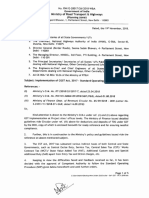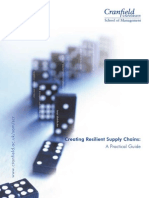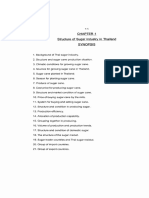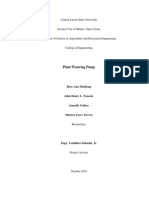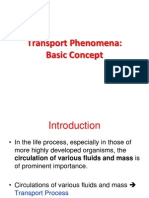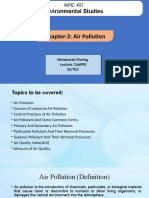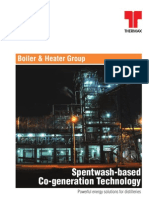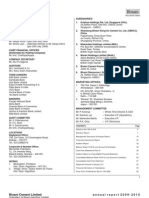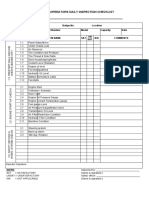MSW in Ludhiana
MSW in Ludhiana
Uploaded by
Mohit NagarCopyright:
Available Formats
MSW in Ludhiana
MSW in Ludhiana
Uploaded by
Mohit NagarOriginal Description:
Original Title
Copyright
Available Formats
Share this document
Did you find this document useful?
Is this content inappropriate?
Copyright:
Available Formats
MSW in Ludhiana
MSW in Ludhiana
Uploaded by
Mohit NagarCopyright:
Available Formats
ITPI JOURNAL
I : I (2004) 62-72
I T P I
JOURNAL
www.itpindia.org
MUNICIPAL SOLID WASTE MANAGEM
ENT CURRENT CONCERNS IN LUDHIANA CITY
Ashwani Luthra
Senior Lecturer, Guru Ramdas School of Planning, Guru Nanak Dev University, Amritsar
Rajneesh Sareen
Assistant Consultant, IRG South Asia Pvt. Ltd., New Delhi
ABSTRACT
Fast changing consumption pattern is resulting in production of huge quantities of solid waste, which is haphazardly and unscientifically
disposed off in the urban areas. Fast growing cities are facing critical conditions with respect to solid waste management. Ludhiana,
a rapidly growing industrial city, is producing huge quantities of solid waste each day. The three-fold increase in generation of solid
waste during 1981-2000 has resulted in problems of its collection, transportation and disposal. Technological, managerial and
behavioral aspects are more pronounced amongst all the existing pitfalls, in the system. Audit of solid waste management practices
in Ludhiana identifies the deficiencies, issues and options to be undertaken in right earnest to make the city clean and hygienic. The
author argues that the public awareness about their deeds and misdeeds would be of more relevance in mitigating problems of Solid
Waste Management. The paper is based on empirical study carried out for postgraduate programme in 2001.
1.0 INTRODUCTION
Planning in the field of solid waste management may
be defined as the process by which community needs
regarding waste management are measured and
evaluated and workable alternatives are developed for
adoption by decision makers. It encompasses a wide
range of individual activities. To deal effectively with
solid waste management it would be appropriate to
group the activities into six fundamental elements,
viz,.
Waste Generation
On Site Storage
Collection
Transfer and Transport
Processing and Recovery
Disposal
Combination of these functional elements is known
as Solid Waste Management System. Thus, one
of the goal of management is to provide the best
possible system subjected to the constraints
imposed by its users and those who are affected by
it or who control its use. Ludhiana, the industrial city
sometimes also called as Manchester of India, is
one of the fastly growing metropolitan city with a
growth rate of about 70% per decade. The city is
centrally located in State of Punjab and also receives
a good accessibility due to nearness to the G.T. Road
and railway corridors. Due to which number of
industries and other infrastructure is growing very
fast. Consequently, the consumption pattern is also
taking a fast track, resulting in production of large
quantities of solid wastes that are being haphazardly
and unscientifically disposed and dumped. The
magnitude of waste produced is facing problems in
proper disposal, reuse, etc., alternatively it can be
taped for energy production, recycling, optimum
utility, scientific disposal, to prevent it from spreading
of health hazards to other residents of the city and
also progress towards clean technologies.
2.0 SOLID WASTE MANAGEMENT IN LUDHIANA
The Ludhiana Municipal Corporation was set up in
1976. Main functions performed by Municipal
Corporation, Ludhiana (MCL) in solid waste
management are its collection, transportation and
disposal. The operation and maintenance is carried
out by the Department of Health and Sanitation, which
is formed under Municipal Corporation Act 1976.
Ludhiana is a fast growing city and so is its waste
generation. Whereas it was generating about 316
MT of solid waste per day in 1981, its generation
grew to about 542 MT per day in 1991 and about
1000 MT per day in 2000. The three-fold increment
in solid waste is primarily the result of fast growing
population and changing food habits of the people.
Over a period of time, the city has experienced
problems in waste storage and collection due to lack
of manpower, finances and managerial skills. It is
amazing to know that only 40% of the city is cleaned
by regular sweepers (safai sewaks) of MCL. The safai
sewaks sweep the streets using brooms to make
small heaps of garbage. These heaps of garbage are
Ashwani Luthra / Rajneesh Sareen / ITPI Journal I : I (2004) 62-72
Information on the properties of solid wastes is
important in evaluating alternative equipment needs,
systems, and management programme and plans,
especially with respect to the implementation of
disposal and resource / energy recovery options.
Composition of municipal solid waste and their relative
distribution are reported for Ludhiana City in Table 1.
It is clear from the table that as much as 46% of
solid waste in the residential areas of the city is
biodegradable i.e. vegetable matter. Another 32% is
also harmless substance i.e. ash / fine earth, meaning
th
thereby that more than of the garbage does not
carry harmful substances. So is the case at market
places, where its total composition is more i.e. 82%.
About 60% and 91% of the waste of commercial and
industrial areas respectively is the real cause of
concern.
then taken to nearest filth depot in wheelbarrows.
Very recently, MCL has introduced 50 tricycle
rickshaws. These cycle rickshaws have six small
bins to collect garbage. Two to three sweepers cover
1 beat per day, which includes 1-km length of street
with 20 feet width (6000 sq.mt.). About 365 beats
are done successfully on each day.
There are about 380 garbage containers placed at
various places in the city, comprising of 9 pucca filth
depots, 29 D. P. containers, 15 hauler tuggers and
152 open yards. They are used only for collection of
garbage and are distributed across the main central
areas of the city. The process of collection of garbage
is still primitive in nature. There are about 600 plastic
bins in the market areas and MCL is planning to
install 700 more in near future. Partly underground
containers were also provided as pilot project in order
to avoid ugly visibility of the container. The idea,
however, failed due to the problems of water logging.
The garbage from the filth depots is transported to
the dumping grounds with the help of loaders and
tippers. The infrastructure of MCL for transportation
of wastes is given in Table 2.
Table 1: Physical and Chemical Composition of the Waste in Different Areas of City
Physical Characteristics
Residential
Area (%)
Commercial
Areas (%)
Market
Places (%)
Industrial Areas
(%)
1.74
4.60
9.50
0.34
0.52
0.40
0.62
0.88
0.25
2.5
32.32
46.33
11.42
5.65
11.29
2.28
9.14
3.36
10.22
5.65
27.28
13.71
0.54
0.68
4.34
0.41
0.68
4.34
1.09
26.05
61.87
4.13
14.47
9.25
5.12
7.28
12.40
38.09
9.26
-
Paper
Plastics
Rags
Metals
Glass
Rubber Leathers
Wood Matter
Earthware
Bones
Stone Bricks
Ash / Fine Earth
Vegetative Matter
Source: MCL Zonal Offices, June 2000.
Table 2: Description of Infrastructure Facilities Available with MCL for SWM
Infrastruc
JCB
Wheel
ture Type Loaders Barrows
Number
500
Hauler
Tugger
Tractor
with
Trailers
Dumper Small Tippers
Road
Tricycle
Placers loaders
Cleaning Rickshaws
(vacuum)
Machines
25
10
26
4
50
Source: MCL Zonal Offices, June 2000.
MCL as on today has adopted landfilling for disposal
of the waste. There are two garbage disposal points
for MCL outside the city, one on Hambran Road at
Jainpur Village having 25 acres area which is about
20 years old, and other one is on Tajpur road
comprising of 30 acres on the opposite side of the
city. MCL has also identified one site for compost
plant. No environmental safeguards for protecting
disposal sites to prevent breeding of insects nor
action for proper disposal has been taken till date.
63
Ashwani Luthra / Rajneesh Sareen / ITPI Journal I : I (2004) 62-72
Due to which these disposal sites, are deficient of
proper disposal technologies, endangering
environment in term of soil, aesthetics as well as
water pollution.
3.0 PROBLEMS AND ISSUES IN SOLID WASTE
MANAGEMENT IN LUDHIANA
There are possibilities of introducing door to door
collection in few areas of Zone D i.e. areas like
Bhai Ranjit Singh Nagar, Sarabha Nagar, etc.
This can help in timely collection and disposal
in desired way.
Shops/ Offices/ Establishments
Based on the empirical data and its analysis,
following problems and issues have been identified
and categorized:
Waste consists of food waste and other
discarded waste materials such as paper, plastic,
glass, metal, rags / packaging materials.
3.1.
Collection and Storage of Waste
3.1.1.
Storage of Recyclable Waste at Source;
3.1.2.
Segregation of Waste at Source;
3.1.3.
Primary Collection of Waste;
3.1.4.
Waste Storage Depot; and
Most often waste is thrown on the street at
random hours and around the bin and not into it
and thus wastes comes on the roads, streets
and lanes treating the public streets as
receptacle of waste.
3.1.5.
Street Sweeping
3.2
Transportation of Waste
3.3
Disposal of Waste
In almost all-commercial areas, sweeping
process is completed before 9.00 A.M. and
shops / establishments opening later which
throw the wastes on the streets / footpaths.
Most shops / establishments do not allow MCL
to place dustbins near to their shops /
establishments.
Some of these shops keep large bins for the
storage of waste and quite often contract out
the collection of recyclable waste deposited in
these bins or hand over such waste-to-waste
purchasers/waste pickers. The unwanted part
of this waste also finds its way on to the streets.
There are possibilities of introducing shop to shop
collection in few areas of Zone D i.e. areas like
Feroze Gandhi Market, Ghumar Mandi and
Sarabha Nagar.
A detailed description about each aspect will clarify
the nature and extent of the problem of solid waste
management in Ludhiana City.
3.1.1.
Storage of Re-cyclable Waste at Source
Storage at the source of waste generation is the first
essential step towards appropriate waste
management, which is substantially lacking in
Ludhiana.
Households
Waste consists of food waste and other
discarded waste materials such as paper, plastic,
glass, metal, rags, packaging materials.
Most households often throw waste on the street
at random hours and around the bin and not into
it.
Thus waste gets spread on the roads, streets
and lanes treating the public streets as
receptacle of waste.
Most households do not allow MCL to place
dustbins near their house.
Due to untimely and ill managed disposal of waste
by households the management aspect gets
lost.
Construction and Demolition Waste
In H.I.G and M.I.G areas most of residents pay
Rs.10 per month presently, to their maids for
transport of waste from household to the
collection points in respective locations.
64
This waste is generated mainly by repair,
maintenance and, reconstruction activities. It
contains bricks, cement concrete, stones, tiles,
wood, etc.
The storage of this waste at the time of its
generation and its disposal is totally neglected.
By and large, people deposit construction waste,
after salvaging useful material, just outside their
houses / shops / establishments or on the
streets or along major roads, creating nuisance,
pollution and obstruction to traffic.
Ashwani Luthra / Rajneesh Sareen / ITPI Journal I : I (2004) 62-72
3.1.2.
Segregation of Recyclable Waste at
Source
deposit the waste on the streets, along the
drains, etc., which is thereafter collected during
street sweeping operations, the next day, which
remains a source of visual as well as health
nuisance throughout a day.
Following features highlight the problems and issues
related to segregation of waste in different parts of
the city.
Households / Shops / Offices / Establishments
3.1.4.
Households and establishments in Ludhiana do
not practice segregation of recyclable waste at
source at all.
Following are some of the salient features
Households / Shops / Offices / Establishments
The storage points / depots are deficient in
Ludhiana. The dustbin per ten thousand persons
ratio has large variations ranging from 0.36 to
0.41 at different locations as against 1.00 as per
the standards.
Even the capacity of the collection points is not
sufficient. There is mismatch between the
garbage generation and the carrying capacity of
the bins. This makes the spill over of the
containers and makes the area filthy.
The filth depots are not protected properly from
stray animals and rag pickers which spread the
garbage. Proper drainage needs to be provided
specifically during rainy season.
Distance between the households and bins is
also large, varying from 50 meters to 500 meters.
As a result, quite a large number of people
deposit the waste on the streets, which is
thereafter collected during street sweeping
operations the next day.
Currently, there is no arrangement for house-tohouse collection of waste in Ludhiana.
The sites where the bins are provided are not
properly paved, giving rise to unhygienic
conditions around the bin. This compels people
to throw the waste from a distance just outside
the bin instead of throwing it inside the bin. More
waste thus is dumped outside the bin than inside
it.
Community bins are also not available at
convenient locations in Ludhiana for depositing
waste. Even at places where these have been
provided, it has been observed that these are
often inadequate in size and spaced too far apart
and ill managed.
In many areas / localities, open sites exists
where waste is just dumped by the Safai Sewaks,
which is resulting into health hazards and source
of visual pollution.
The general public does not allow Containers /
Collection Bins to be placed near to their house
/ property.
Many of the collection points are located on the
roadsides. The spillovers from these collection
points make the whole area filthy. Moreover, the
lifting of the garbage from these areas is also
Such waste on the streets or in the municipal
bins goes to disposal sites un-segregated which
on one side retards the decomposition process
and on other hand increases the load on the
disposal sites i.e. more space requirements for
waste disposal.
In absence of the practice of segregation of waste
at source, part of this waste is picked up by rag
pickers in soiled condition because of which they
have danger to their health.
At times for sorting and collection, they empty
the dustbins and spread the contents around.
This practice makes the scene filthy i.e. more
breeding grounds for flies, unhygienic scene and
becomes more time consuming in collection.
There are possibilities of introducing source
segregation in few areas of Zone D i.e. areas
like Bnai Ranjit Singh Nagar, Feroze Gandhi
Market / Ghumar Mandi and Sarabha Nagar as
these areas have some open spaces for
performing such activities.
3.1.3.
Primary Collection of Waste
Following are some of the salient features
Households / Shops / Offices / Establishments
Waste Storage Depots
Distance between the households and bins is
also large, varying from 50 meters to 500 meters.
As a result, quite a large number of people
65
Ashwani Luthra / Rajneesh Sareen / ITPI Journal I : I (2004) 62-72
done once in a day due to which dirt remains
lying whole day creating nuisance and
congestion to the passing traffic.
9.00 am and start throwing their waste on the
streets, nullifying the work just done by the safai
sewaks.
Many of the collection points are located in the
properties not belonging to the MCL. Some of
the bins are even located on the private plots.
The MCL needs to identify new plots / properties
belonging to MCL to place these bins.
Safai sewaks sweep the street with a short
handle or long handle brooms. While sweeping /
initially they make small heaps of waste on the
street and then load this waste into their
wheelbarrows.
Open collection yards are the critical areas for
further action. Proper strategy needs to be
adopted to tackle these problems,
Recently, tricycles are used to transport larger
quantity to longer distance.
3.1.5.
Tools Used
Street Sweeping
Following are some of the salient features
General Aspects
It is observed that all roads and streets are not
being swept on daily basis. In practice certain
important roads and markets are swept daily,
some are swept on alternate days or twice a
week, some are swept occasionally or not at
all.
The road length to be swept by a sweeper is
standardized. However, there is no scientific
planning to direct, which street should be swept
daily or alternate days or twice a week, etc.,
depending on the concentration of population /
activity on the roads and lanes.
There is a definite yardstick prescribed for each
sweeper. 2-3 safai sewaks are expected to cover
1 beat per day, which includes 2 safai sewaks
covering 1-km length of street of width 20-feet
(5000 sq. mt.) and one sweeper needs to clean
drains less than 3-feet width of length 1-km.
However, safai sewaks are allotted work as per
road length irrespective of density of population.
Short handle brooms are generally given to safai
sewaks for street sweeping.
There is no uniformity in the number and quality
of brooms given to safai sewaks. On an average,
they are given 1 broom per month. Inadequate
supply of tools to the safai sewaks reduces their
efficiency.
A wheelbarrow / tricycle is a very essential tool
for a sweeper to carry street sweepings to the
dustbin site. But these are ill designed as it is
difficult to move and they have to be upturned for
unloading the contents on to the ground. This
creates difficulty in transporting and unsanitary
conditions near the dustbin exist.
3.2.
Transportation of Waste
Following are some of the glaring problems and issues
related to the transportation of solid waste in
Ludhiana City.
General Aspects
In Ludhiana each safai sewak works for 5-days
a week, as a result, sweeping is done only for 5
days keeping the dirt / dust without sweeping
on Saturdays and Sundays.
Transportation system is a mix of fast moving
and slow moving vehicles. There is a wide
variation in the output of vehicles ranging from
tractor-trailer to tippers.
The carrying capacity of the vehicles based on
the number of trips made is not sufficient for
handling the garbage at 100 percent utilization
Timing and Methodology
Generally / street sweeping is done only once in
a day during morning for 3-4 hours.
About 40 percent of vehicles are out of operation
every day.
The fleet of vehicles is not optimally utilized.
The system is a potential health hazard for the
workers, as all types of waste, including hospital
infectious waste, human excreta are disposed
of in the common dust bin or on the streets.
Though official duty hours are 8 hours a day, the
actual work is done only 5-6 hours a day.
Sweeping in commercial areas begins in the
morning around 6.30 am, but shops open after
66
Ashwani Luthra / Rajneesh Sareen / ITPI Journal I : I (2004) 62-72
Arrangement for separate collection of infectious
biomedical waste is practically non-existent.
Spare-parts procurement via frequent tenders is
cumbersome and slow.
Common storage points such, as Filth Depots
are not compatible with the tipper trucks. This
makes the loading operation a cumbersome
process.
The maintenance of SWM vehicle gets low priority
and as a result many old vehicles, which require
frequent repairs and maintenance, are still
operating in the city.
Waste is usually transported uncovered creating
nuisance. Moreover transportation takes place
in the daytime during peak hours and affected
by traffic conditions.
There are no transfer stations for slow moving
vehicles like tractor-trailers, As a result, these
vehicles also need to travel 10-12 km up to
dumping ground taking more time.
Vehicles are outdated and more than 7 years
old. They give low mileage and are subjected to
frequent breakdowns.
Maintenance of the vehicles is very poor and
down time of the vehicles is very high.
The transportation fleet deployment does not
synchronize with the types and capacities of
dustbins provided. No monitoring of vehicle
movement is done
The loading time of loader is 10 minutes. However
it is also subjected to frequent breakdowns
because of faults in mechanical parts.
There is no scientific ways of calculating the
waste generation. As a result the efficiency of
collection and transportation can not be
established.
Segregation of solid wastes is not in the
organized sector which results into more
quantities of wastes being transported to the
sanitary landfill than what should be actually
transported. There is absence of segregation
facilities like solid waste batching stations.
There are no weighing machines at the dumping
stations. As a result, there is no statistics on
the collection and transportation of the garbage
to make officials accountable for
mismanagement.
Dumping of wastes is carried in open, sides of
drains, backyards of houses, etc., thereby
increasing the number of collection points and
worsening the scenario.
3.3.
MCL as on today has adopted landfilling for
disposal of the waste. There are two garbage
disposal points for MCL outside the city. One is
on Hambran Road at Jainpur Village having 25
acres area which is about 20 years old, and other
one is on Tajpur road on the opposite side of the
city over an area of 30 acres.
MCL also identified one site for compost plant.
No environmental safeguards for protecting
disposal sites to prevent breeding of insects has
been taken due to which these disposal sites
are, deficient of proper disposal technologies,
and posing a threat to environment in term of
soil, aesthetics as well as water pollution.
In 1998 there was a fire outbreak at Jainpura
Village disposal site and fire department took
two days to overcome this. This was because of
uncontrolled disposal leading to production of
methane gas.
Two earlier disposal sites i.e. the landfill areas
where 8-10 feet lower in height than surroundings,
Management Aspects
In many cases, waste handling is done
manually. Loading and unloading being time
consuming, it reduces the productivity of
manpower and vehicles. As loading is labor
intensive, is affected by the non-availability of
laborers.
The route pattern is given to every vehicle.
However, due to the malfunctioning and absence
of these vehicles on route, the other vehicles are
diverted to attend the areas. This forces the
vehicles not to stick to the routes that have been
specified. Garbage trolleys routes are not based
on shortest path due to which more time and
money is consumed.
There is only one workshop for whole city. Even
for the small and minor repairs, the vehicles
needs to travel to these workshops.
67
Disposal of Waste
Ashwani Luthra / Rajneesh Sareen / ITPI Journal I : I (2004) 62-72
transportation and disposal are the important aspects
in solid waste management, recommendations and
suggested plans of action are given under these
headings.
but now these areas have grown to the sizes i.e.
5-7 feet above the surrounding land height making
the adjacent properties prone to pollution due to
water seepage from disposal site. These
landfilling sites needs to be shifted or be replaced
by other safer methods.
4.1
4.0 RECOMMENDATIONS AND PROPOSALS
COLLECTION AND STORAGE OF
MUNICIPAL SOLID WASTE
Based on the findings of empirical studies and
problems and issues associated with collection and
storage of solid waste actions areas for different parts
of city have been identified and given in Table 4.
As per projections (refer Table 3) the MCL has to go
a long way to meet the future challenges. This calls
for augmentation and adoption of technologies to keep
pace with the future scenario. Since collection,
Table 3: Solid Waste Management in Ludhiana: Present and Future Scenario
Indicators
Collection
Points/10000
Population
Collection Points in Figures
Capacity
of
Collection
Points (MT)
Effective Safai Sewaks/
1000 Population
No. of Safai Sewaks
Ratio of Supervisory Staff to
Safai Sewaks
No. of Supervisory Staff (as
per the Norm)
Carrying Capacity of the
Vehicles
(@
65%
Operation)
Present Scenario (2001)
Existing
Standard
Deficiency
0.36
1.00
0.64
Future Scenario (2021)
Required
Deficiency
1.00
0.64
154
704
1000
294
554
2885.5
400
2181.5
1.23
2.80
1.57
2.80
1.57
3304
29.48
5301
25
2057
Favorable
15537
25
12233
Favorable
88
212
124
621
533
620
1000
380
2748
2128
Table - 4: Collection and Storage of Municipal Solid Waste
Action Areas
Current Status
H.I.G Localities
Sarabha Nagar
Aggar Nagar
Dugri Road
Tagore Nagar
Kitchlu Nagar
Bhai Randhir Singh
Nagar
Suggested Plan of Action
Posh residential areas
No house-to-house collection
& segregation of recyclable
wastes at source.
68
Introduce house-to-house collection system by MCL safai sewaks.
Introduce door-to-door collection
by NGOs/CBOs/ private sector
involvements. Possible organizations
are
Exnora-Chennai,
Vatavaran-New Delhi & Excell
Industries-Mumbai.
NGOs/CBOs/private sector need to
train rag pickers for collection of
recyclable waste.
Vermicomposting should be
introduced in these localities.
Alternatively, MCL may introduce by
itself on full cost recovery basis.
Ashwani Luthra / Rajneesh Sareen / ITPI Journal I : I (2004) 62-72
Slums
There is no unified system
Market Areas
Feroze Gandhi
market
Sarabha nagar
Ghumar mandi
MCL safai sewaks are
operating
Hotels
Restaurants
Banquet /
Community Halls
Wastes are mixed
with municipal wastes
Construction waste
No unified system
Added to municipal wastes.
Street Sweeping
Street sweeping is done
only five days a week.
Beat size doesnt consider
density of the area.
Outdated wheelbarrows
are in use.
Tricycles are used without bins.
Both long/short handle
brooms are in use
69
Encourage and promote Mohalla
Sanitation Committees for slums
Alternatively, involve NGOs/CBOs to
create awareness and train rag
pickers for collection of recyclable
waste.
Promote Mohalla Sanitation
Committees with may be trained
rag pickers for picking recyclable
wastes.
Alternatively MCL may introduce
shop-to-shop collection on full cost
recovery basis.
Introduce licenses to all these
establishments
to
comply
mandatory recommendations.
Offenders need to be penalized
heavily.
MCL officials need to monitor closely.
MCL shall make it mandatory
while granting construction permits
to deposit waste collection,
transportation and disposal fees to
make it full cost recovery affair on
per ton basis.
The charges for removal of
construction waste to be doubled for
those who fail to deposit the amount
in advance.
MCL may introduce a container
renting, the containers may be
transported by hydraulic system at
a time mutually agreed upon between
the MCL and waste producer.
Sweeping should started in the
morning as early as possible.
MCL needs to reschedule the
working days of its employees of
Health and Sanitation Department
preferably on shift basis, providing
compensatory of two days a
week to every employee with
street sweeping done on all days of
a year.
Ashwani Luthra / Rajneesh Sareen / ITPI Journal I : I (2004) 62-72
Beat size shall be redefined as per the
guidelines based on density.
Wheelbarrows need to redesigned
with 4 bins for women safai sewaks
and tricycles 0f 6 bins for men safai
sewaks. Every safai sewak should be
provided with wheel barrow/ tricycle.
Trays/metal plates to be provided to
sweepers.
Small vacuum cleaners for streets can
be tried in certain area for street
cleaning.
Storage Bins
Filth depots protected
four sides by wall and
sometimes by a roof.
D.P containers/ Hauler
Tuggers, good in design
by placing but practices
are improper.
Open yards are unprotected
and mainly on roadsides
Many storage bins located
on plots not belonging to MCL.
Shortage of number of bins.
Spacing between bins is too
long.
Troley-railway line
Udham Singh Nager
Baba Than singh
Chowk Shivaji Nagar
D.P containers/ Hauler
Tuggers and open collection
points located next to nallah
70
Filth depots/ transfer points
should be introduced in more
number with new improved
design, which should match to
loader and tipper height.
The design and capacity of
containers are good. However,
MCL employees shall ensure that
these are kept in place with
shutters open and the surround
ings shall be hygienic to facilitate
public to dump garbage in to the
bins.
The D.P containers/ Hauler Tuggers
should be placed on cement concrete
or asphalt flooring having a gradual
slope towards the road.
Number of bins shall be increased on
the guidelines provided.
MCL to locate new plots for storage
bins.
Avoid burning wastes in containers.
Paint containers in three months.
Old containers should be replaced with
the new one.
Discard open spaces and replace with
D.P. containers/Hauler Tuggers in
phased manner.
Collection/storage points should
be protected to prevent garbage
spilling to drains.
Construct 4-5 feet wall partition where
storage is located next to nallah.
MCL supervisors to penalize the
offenders who dump garbage to nallah.
O&M cell to clear garbage in nallah
on weekly basis.
Ashwani Luthra / Rajneesh Sareen / ITPI Journal I : I (2004) 62-72
4.2.
Transportation of Municipal Solid Waste
waste once lifted should not touch the ground
till it reaches the disposal site. It is proposed
that concrete masonry structures should be used
as transfer point.
Studies were carried out on different types of refuse
collecting equipments and the costing for these
equipments was derived for two scenarios with round
trip travel of 30 minutes and 80 minutes. The refuse
collecting equipment evaluated were:
Tractor with open trailers.
Tractor shuttle system with open trailers.
Side loading lorry
Rear loader with multiple bins
Rear loaders
The findings of the study were that the round trip
travel time to the disposal site should not be more
than 75 minutes. In order to decrease the cost per
ton it was proposed that either the capacity of the
vehicles should be increased or round trip travel time
should be reduced. Providing transfer facilities where
the small trucks dump the waste and it is then carried
to the disposal site in larger capacity vehicles would
be advisable. It was further proposed that segregation
facilities could be provided at the transfer points.
Portable containers with trucks fitted with
hydraulic lifting equipment are proposed.
The solid waste management system should be
based on the fundamental principle that solid
Vehicle replacement should be at the end of 6
years as salvage value is 5%, considering rate
of depreciation is 40%.
Solid waste batching stations should be at
transfer points to minimize cost of operation. This
can help in reducing quantum of wastes to be
transported to disposal point.
It is proposed that waste be transported in small
capacity trucks of 5 tons between common
storage and transfer stations and in large
capacity trucks of 13 tons between transfer
station and disposal point.
Disposal of Municipal Solid Waste
There are different technologies, which can be used
for final disposal of municipal solid waste. Some of
the major processes are listed below and their
comparative advantages and disadvantages are listed
in Table 5 and 6.
Selection of vehicle type should be based on
the freedom/ flexibility in loading/ unloading
operations, which would minimize loading/
unloading time. In context of present solid waste
management, trucks fitted with hoisting
equipment or hydraulic lifts are most appropriate.
Average round a trip travel time should be 75
minutes. Suitable location for transfer stations
should be identified so as to make disposal of
solid wastes more effective .
4.3.
Transportation Strategy
Biomethanation;
Sanitary landfill gas;
Pelletisation;
Pyrolysis/ Gasification;
Composting; and
Incineration.
Table 5: Various Waste Disposal Methods and their Merits and Demerits
Method of Disposal
Land Filling
Open Land Dumping
Demerits
Restricted site availability
can not last longer
Contaminated water sources
Anaerobic gas production explosions
Merits
Easy operation
Land gets leveled
Environmental pollution
Costly large area required
Increasing maintenance cost
of open dumps
Lower initial costs
Easy for rag pickers
Non-skilled job
71
Ashwani Luthra / Rajneesh Sareen / ITPI Journal I : I (2004) 62-72
Burning/ Incineration
Bio-conversion into
Organic Manure
Smoke and fire
Shifting of locations due to space
becoming full
Smoke and gaseous contamination
Temperature rise
Diesel costs higher
Capacity for incineration is a constraint
Technological constraints
Higher capital costs
Requires government support
Value addition to waste resource
Sustainable approach
Incineration is standard
hygienic operation
Burning
is
easy
operation
Highly useful product for
improvement of crops.
Table 6: Inter Technological Comparison
Technology
Biomethanation
Pelletisation
Incineration
Composting
MSW Quantity (t)
150
125
100
150
Land Required (Acre)
6
3
2
7.5
Cost (*10 Rs)
6-9
4.0
6.0
1.5
Source: CPCB, Management of Municipal Solid Waste, 2000.
It is proposed that composting by anaerobic
conversion is of more relevance to Ludhiana; as other
technologies are not economically feasible at
present. Moreover, the physical and chemical
compositions of waste are quite favorable for this
kind of treatment facility. There are different types of
composting, being practiced in India but mechanized
composting is quite suitable for Ludhiana because
of advantages like lesser land requirement, speedy
process, high capacity operations, and low labour
dependency. No doubt, this process is costlier than
the others, but the amount of advantages this system
offers, can overcome this drawback. As Ludhiana, is
growing at a very faster rate so the future generation
rate of solid waste will be much higher and put
pressure on the disposal options. This system
because of its higher capacity and less time
consumption is more desirable. Moreover, due to nonavailability of the land in Ludhiana this system can
be more appropriate as it consumes lesser space
and gives faster results.
5.0 CONCLUSIONS
The solid waste management in Ludhiana City is
facing deficiencies of varying nature and quantities.
Technological, managerial and behavioral aspects are
more important amongst all the reasons of the
existing pitfalls in the system. However, under given
conditions some hard decisions needs to be taken
to improve and control the system of solid waste
management in the city. More importantly, people
should be made aware about their deeds and
misdeeds. In this regard it has been experienced
that no solid waste management programme be
successful without the proper support of the public.
Public awareness campaign, thus should be back
bone of the system proposed for Ludhiana City.
72
You might also like
- H82FPC CW 1 Autumn 2018-19Document9 pagesH82FPC CW 1 Autumn 2018-19Jayshree MohanNo ratings yet
- EVS - Solid Waste Management (Mumbai)Document5 pagesEVS - Solid Waste Management (Mumbai)Saif Kasmani60% (5)
- GST Act, 2017-SorDocument6 pagesGST Act, 2017-SorMohit NagarNo ratings yet
- Creating Resilient Supply Chains - A Practical GuideDocument100 pagesCreating Resilient Supply Chains - A Practical GuidePeter KlymNo ratings yet
- Construction Method of Steel BridgeDocument95 pagesConstruction Method of Steel BridgeAce Joker100% (2)
- Sugar and Fermentation Industry: Chemical TechnologyDocument53 pagesSugar and Fermentation Industry: Chemical TechnologyMansi SinghNo ratings yet
- Sugar Production in Thailand.Document40 pagesSugar Production in Thailand.JM NY100% (2)
- Fun Bio Med EnggDocument125 pagesFun Bio Med Enggprashant_cool_4_uNo ratings yet
- Dats Equipment ListDocument14 pagesDats Equipment ListVikrant DeshmukhNo ratings yet
- Leaching Notes PDFDocument14 pagesLeaching Notes PDFimmo50% (2)
- Pondash Vs Dry FlyashDocument8 pagesPondash Vs Dry FlyashMere HamsafarNo ratings yet
- 44 - Industrial Pollution Control in GPI 1Document29 pages44 - Industrial Pollution Control in GPI 1anoop kumar singhNo ratings yet
- FACT Project ReportDocument71 pagesFACT Project ReportMegha UnniNo ratings yet
- 06 VR HadwacoDocument43 pages06 VR HadwacoLuis ValdezNo ratings yet
- Central Luzon State University: Plant Watering PumpDocument14 pagesCentral Luzon State University: Plant Watering PumpJohn Henry TenorioNo ratings yet
- Cleaner ProductionDocument5 pagesCleaner ProductionBECCA2908No ratings yet
- Transport Phenomena - Basic ConceptDocument27 pagesTransport Phenomena - Basic Conceptfisika100% (1)
- Power Plant Technology by El WakilDocument46 pagesPower Plant Technology by El WakilMuhammad Yasar Javaid100% (1)
- Process Discription PDFDocument41 pagesProcess Discription PDFAshish TiwariNo ratings yet
- Attero - E - (AutoRecovered) - New Saved PDFDocument10 pagesAttero - E - (AutoRecovered) - New Saved PDFRamesh PatilNo ratings yet
- Waste Paper Collection For Recycling (Overview & Their Reuse Potential)Document7 pagesWaste Paper Collection For Recycling (Overview & Their Reuse Potential)Mayank AgrawalNo ratings yet
- 18bt01036 FFO Lab ManualDocument25 pages18bt01036 FFO Lab ManualSarthak LathiyaNo ratings yet
- Membrane Technology in Food ProcessingDocument18 pagesMembrane Technology in Food ProcessingOhol Rohan BhaskarNo ratings yet
- What Sets The SaltMaker Apart 1Document10 pagesWhat Sets The SaltMaker Apart 1Furi Sri RahimahNo ratings yet
- Biscuit MakingDocument8 pagesBiscuit Makingkmsalim007No ratings yet
- COCONUT SHELL - Mesoporous High-surface-Area Activated CarbonDocument9 pagesCOCONUT SHELL - Mesoporous High-surface-Area Activated CarbonMateo AponteNo ratings yet
- Natural and Sustainable Raw Materials For Sanitary Napkin 2165 8064 1000308 PDFDocument3 pagesNatural and Sustainable Raw Materials For Sanitary Napkin 2165 8064 1000308 PDFDr. Gunjan SarkarNo ratings yet
- Boric AcidDocument18 pagesBoric AcidElnathan Samson0% (1)
- Carbon Balance of Sugarcane Bioenergy SystemsDocument10 pagesCarbon Balance of Sugarcane Bioenergy SystemsYusron MustainNo ratings yet
- Xyz Industries LTD.: Operation & Maintenance ManualDocument49 pagesXyz Industries LTD.: Operation & Maintenance ManualamolbagadeNo ratings yet
- Hazelo Lab Pvt. LTD., Yadadri Bhuvanagiri District - Draft EIA Report (Part I) PDFDocument263 pagesHazelo Lab Pvt. LTD., Yadadri Bhuvanagiri District - Draft EIA Report (Part I) PDFjyothiNo ratings yet
- Design of Biomethanation Plant and Composting PlantDocument23 pagesDesign of Biomethanation Plant and Composting PlantVaishaliNo ratings yet
- GATE PSU Study Material Plant Design EconomicsDocument14 pagesGATE PSU Study Material Plant Design EconomicsJEFY JEAN ANo ratings yet
- 2 Client List Pre Investment Biomass 25.7.17Document20 pages2 Client List Pre Investment Biomass 25.7.17bei moNo ratings yet
- Air PollutionDocument24 pagesAir Pollutionইসলামিক টিভি100% (1)
- Akshaya Patra - Case StudyDocument2 pagesAkshaya Patra - Case StudySakthi Ganesh0% (1)
- Praj Corporate PresentationDocument65 pagesPraj Corporate PresentationSumit KumarNo ratings yet
- Cryogenic Grining of SpicesDocument12 pagesCryogenic Grining of Spices124swadeshiNo ratings yet
- Official Soap and Detergent ProductionDocument51 pagesOfficial Soap and Detergent ProductionPrakkash RajantheranNo ratings yet
- Greenhouse Effect (SOCIAL PROJECT)Document64 pagesGreenhouse Effect (SOCIAL PROJECT)Rahul NishadNo ratings yet
- Wastewater Characteristics and Appropriate MethodDocument8 pagesWastewater Characteristics and Appropriate MethodFarag Hussein AlhassiNo ratings yet
- Milling of Legume PulsesDocument7 pagesMilling of Legume Pulsessuresh100% (1)
- Sugar Processing StepsDocument17 pagesSugar Processing StepsTehreem_2000No ratings yet
- Production of Lactic Acid From Mango Peel WasteDocument7 pagesProduction of Lactic Acid From Mango Peel WasteFiqa SuccessNo ratings yet
- FORM-1: Proposed of Specialty Chemicals Manufacturing UnitDocument71 pagesFORM-1: Proposed of Specialty Chemicals Manufacturing UnitVijay VaghelaNo ratings yet
- Unit 4 Mechanical SeparationDocument23 pagesUnit 4 Mechanical SeparationSk jahidul IslamNo ratings yet
- Tannery Waste Management - BioEnergy ConsultDocument7 pagesTannery Waste Management - BioEnergy ConsultViswanath KapavarapuNo ratings yet
- Chlorine and Its SafetypDocument54 pagesChlorine and Its SafetypHiranmoy MisraNo ratings yet
- Advanced Waste Water Treatment MethodsDocument8 pagesAdvanced Waste Water Treatment MethodsMaku RajkumarNo ratings yet
- Spentwash-Based Co-Generation Technology: Boiler & Heater GroupDocument6 pagesSpentwash-Based Co-Generation Technology: Boiler & Heater GroupPrashanth VaranasiNo ratings yet
- Proposal Format - NUMLDocument5 pagesProposal Format - NUMLHafiz ABNo ratings yet
- Co Processing of Waste in Cement Industr - GrasimDocument12 pagesCo Processing of Waste in Cement Industr - GrasimSantrupta PandaNo ratings yet
- NFL Final ReportDocument74 pagesNFL Final Reportaman11750No ratings yet
- Waste Water Treatment Technology-AOPDocument12 pagesWaste Water Treatment Technology-AOPkamaradNo ratings yet
- April Water Balance ChartDocument1 pageApril Water Balance Charttej94No ratings yet
- StyreneDocument22 pagesStyreneMohd Masri A. Razak100% (1)
- Mechanical Properties of Oil Palm Fibre-Reinforced Polymer Composites: A ReviewDocument33 pagesMechanical Properties of Oil Palm Fibre-Reinforced Polymer Composites: A ReviewjaviergagocampusanoNo ratings yet
- E-Waste Management: A Case Study of Bangalore, IndiaDocument5 pagesE-Waste Management: A Case Study of Bangalore, IndiaJatindra Kumar PradhanNo ratings yet
- Binani CementDocument95 pagesBinani Cementlb2111No ratings yet
- Waste Leather IndustryDocument53 pagesWaste Leather IndustryDwi Bayu Prastyanto100% (1)
- 6 Adiabaticcalorimetry PDFDocument14 pages6 Adiabaticcalorimetry PDFEvelyn TapiaNo ratings yet
- Case StudyDocument18 pagesCase StudysagrvNo ratings yet
- List of Arbitrators Empanelled in IRC PDFDocument15 pagesList of Arbitrators Empanelled in IRC PDFMohit Nagar100% (1)
- Accident Black Spots Letter PDFDocument3 pagesAccident Black Spots Letter PDFMohit Nagar0% (1)
- Government of Madhya Predesh Public Health Engineering DepartmentDocument173 pagesGovernment of Madhya Predesh Public Health Engineering DepartmentMohit NagarNo ratings yet
- NewItem 99 NewItem 99 5Document16 pagesNewItem 99 NewItem 99 5Mohit NagarNo ratings yet
- PT 365 Culture 2017Document1 pagePT 365 Culture 2017Mohit NagarNo ratings yet
- MSW in Kohima City, IndiaDocument8 pagesMSW in Kohima City, IndiaMohit NagarNo ratings yet
- Village Level Survey RDLDocument37 pagesVillage Level Survey RDLMohit NagarNo ratings yet
- Tunneling Introduction To TPKBDocument55 pagesTunneling Introduction To TPKBHansen ChouNo ratings yet
- Work-Life of Indian Railway's Drivers (Loco-Pilots)Document10 pagesWork-Life of Indian Railway's Drivers (Loco-Pilots)Irlro-locopilot Tradeunion100% (1)
- Installation Manual Esgi2 R115 EngDocument27 pagesInstallation Manual Esgi2 R115 EngKhateeb RehmanNo ratings yet
- Specifications: Standard Equipment OptionsDocument16 pagesSpecifications: Standard Equipment Optionsanon_664850107No ratings yet
- MC-10165512-0001 Subaru Forester FB25 RECALLDocument8 pagesMC-10165512-0001 Subaru Forester FB25 RECALLFelipe TeareNo ratings yet
- International Standard Classification by Vessel TypeDocument2 pagesInternational Standard Classification by Vessel TypeLucas GuesseNo ratings yet
- CH62 Lighting SystemDocument94 pagesCH62 Lighting SystemYaQodNo ratings yet
- G25 ĐỀ THEO FORM 2025 - Mai Thư-CHỈNHDocument4 pagesG25 ĐỀ THEO FORM 2025 - Mai Thư-CHỈNHkhanhhoi.clcNo ratings yet
- Gurugram ManufacturingDocument9 pagesGurugram Manufacturingmaanas.pandeyNo ratings yet
- Vocabulary of HolidayDocument3 pagesVocabulary of Holidaydoctor_carmonaNo ratings yet
- A HOOV MC001 E - 11 - Appendices - 343 380Document38 pagesA HOOV MC001 E - 11 - Appendices - 343 380rezandriansyahNo ratings yet
- Poured Joint With Backer Rod 21110Document2 pagesPoured Joint With Backer Rod 21110جميل عبد الله الحماطيNo ratings yet
- BatanesDocument3 pagesBatanesDang GaerlanNo ratings yet
- Form 33Document1 pageForm 33Mela RavalNo ratings yet
- Hitachi Sumitomo SCX2500 - L611-0903 (TW)Document16 pagesHitachi Sumitomo SCX2500 - L611-0903 (TW)lkc 8No ratings yet
- Types of Interchanges NotesDocument7 pagesTypes of Interchanges NotesMeenu TomsonNo ratings yet
- Fact Sheet B3540L - AG - 07.engines - 2p - 04.06.12 - tcm92-37513Document2 pagesFact Sheet B3540L - AG - 07.engines - 2p - 04.06.12 - tcm92-37513Pankaj KambleNo ratings yet
- Railway CablesDocument252 pagesRailway Cableskbs prabhakarNo ratings yet
- Railway CompressorsDocument8 pagesRailway CompressorsJohn DekaNo ratings yet
- Collection of Maritime Press ClippingsDocument32 pagesCollection of Maritime Press ClippingsNarayana PrakashNo ratings yet
- S. No. Manufacturer Vehicle Model / Variant Kerb Weight (KGS) Engine CC Emission Stage Fuel Type (Gasoline / Diesel / CNG / LPG, Etc.) FE (KMPL)Document5 pagesS. No. Manufacturer Vehicle Model / Variant Kerb Weight (KGS) Engine CC Emission Stage Fuel Type (Gasoline / Diesel / CNG / LPG, Etc.) FE (KMPL)Abhishek AryaNo ratings yet
- Mikasa mt74Document50 pagesMikasa mt74theimproviserNo ratings yet
- JoulestoWatts Business Solutions PVT LTDDocument7 pagesJoulestoWatts Business Solutions PVT LTDChandrashekar EvervantageNo ratings yet
- Feb 20 Variance Analysis TemplateDocument1 pageFeb 20 Variance Analysis TemplateHeli Senn VentenillaNo ratings yet
- 02 DRAFT Cork City Road Traffic (Special Speed Limits) Bye - Laws 2024 - 0Document23 pages02 DRAFT Cork City Road Traffic (Special Speed Limits) Bye - Laws 2024 - 0Jack CareyNo ratings yet
- Backhoe Safety Inspection ChecklistDocument1 pageBackhoe Safety Inspection ChecklistImran Alam100% (1)
- Soma ProjectDocument9 pagesSoma ProjectParman S SidhuNo ratings yet
- LCD ManualDocument4 pagesLCD ManualTibor KerestesNo ratings yet



